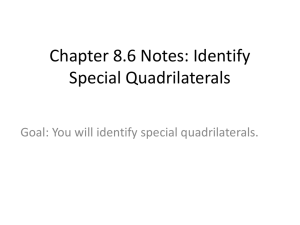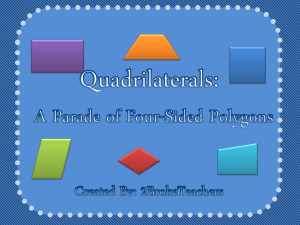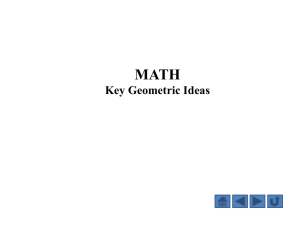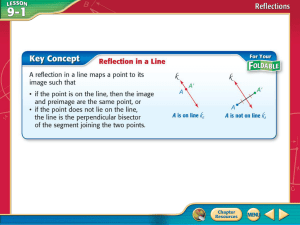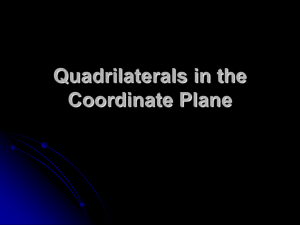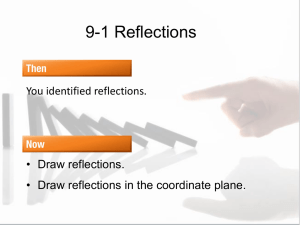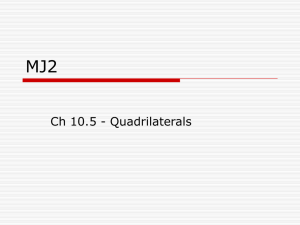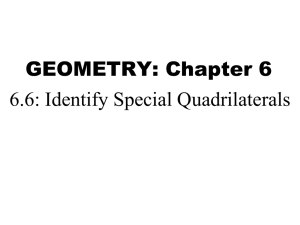7017 b Transformations Student Worksheet
advertisement
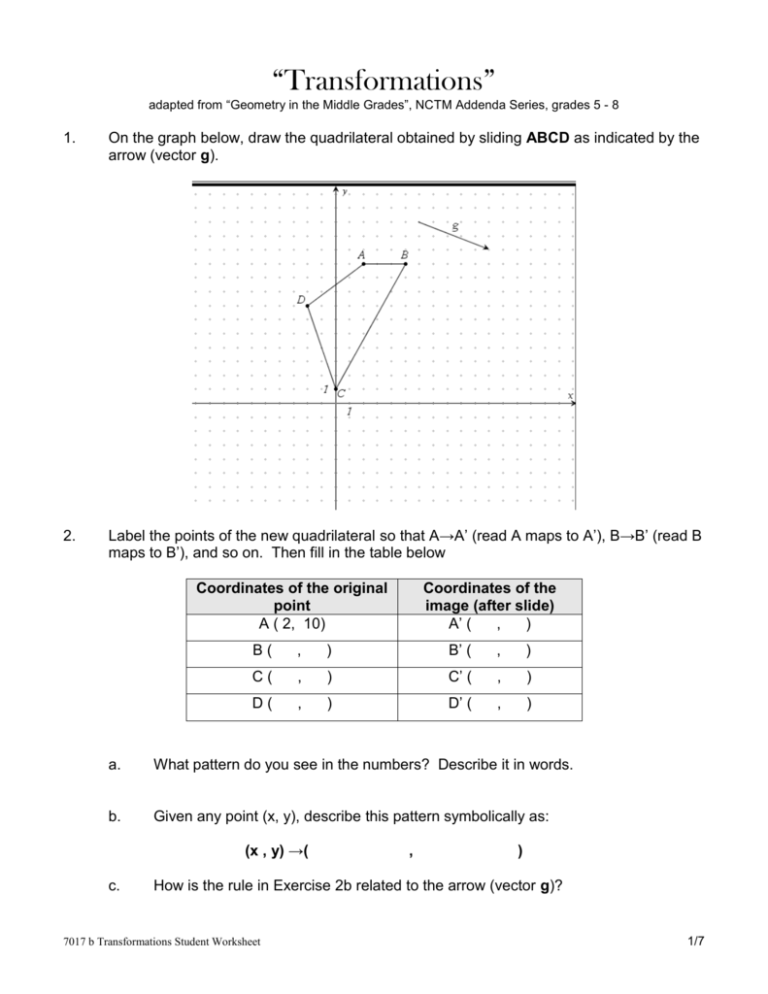
“Transformations” adapted from “Geometry in the Middle Grades”, NCTM Addenda Series, grades 5 - 8 1. On the graph below, draw the quadrilateral obtained by sliding ABCD as indicated by the arrow (vector g). 2. Label the points of the new quadrilateral so that A→A’ (read A maps to A’), B→B’ (read B maps to B’), and so on. Then fill in the table below Coordinates of the original point A ( 2, 10) Coordinates of the image (after slide) A’ ( , ) B( , ) B’ ( , ) C( , ) C’ ( , ) D( , ) D’ ( , ) a. What pattern do you see in the numbers? Describe it in words. b. Given any point (x, y), describe this pattern symbolically as: (x , y) →( c. , ) How is the rule in Exercise 2b related to the arrow (vector g)? 7017 b Transformations Student Worksheet 1/7 3. On the graph below, draw a new vector (or arrow) on the graph below. Draw and label the quadrilateral obtained by sliding ABCD as indicated by your vector. Given any point (x, y), describe your slide in words and symbolically: Words Symbolically (x , y) →( , ) Check with your teacher before you proceed to the next exercise. 7017 b Transformations Student Worksheet 2/7 4. On the graph below, draw the quadrilateral obtained by flipping EFGH over the dotted line, y = x. 5. Label the points of the new quadrilateral so that E→ E’, F→ F’, and so on. Then fill in the table below. Coordinates of the original point E ( 5, 11) Coordinates of the image (after reflection) E’ ( , ) F( , ) F’ ( , ) G( , ) G’ ( , ) H( , ) H’ ( , ) a. What pattern do you see in the numbers? Describe it in words. b. Given any point (x, y), describe this pattern symbolically as: (x , y) →( c. , ) What does the line of reflection, y = x, do to segments EE’, FF’, GG’, and HH’? Explain. Check with your teacher before you proceed to the next exercise. 7017 b Transformations Student Worksheet 3/7 6. On the graph below, do each of the following: a. Draw the quadrilateral obtained by flipping EFGH over the x-axis b. Draw the quadrilateral obtained by flipping EFGH over the y-axis c. Draw the quadrilateral obtained by flipping EFGH over the dotted line y = - x In the space provided below, describe each reflection in words and symbolically. In Words Symbolically a (x , y) →( , ) b (x , y) →( , ) c (x , y) →( , ) Check with your teacher before you proceed to the next exercise. 7017 b Transformations Student Worksheet 4/7 7. On the graph below, draw the quadrilateral obtained by rotating quadrilateral JKLM clockwise 90º about the origin (point O). 8. Label the points of the new quadrilateral so that J→J’, K→K’, and so on. Then fill in the table below: Coordinates of the Coordinates of the original point image (rotation) J ( -5 , 5 ) J’ ( , ) K( , ) K’ ( , ) L( , ) L’ ( , ) M( , ) M’ ( , ) a. What pattern do you see in the numbers? Describe it in words. b. Given any point (x, y), describe this pattern symbolically as: (x , y) →( , ) c. What single rotation counter-clockwise (about the origin) will map quadrilateral JKLM onto the new quadrilateral J’K’L’M’? d. What are the measures of angles JOJ’, KOK’, LOL’, and MOM’? Check with your teacher before you proceed to the next exercise. 7017 b Transformations Student Worksheet 5/7 9. On the graph below, do each of the following: a. Draw the quadrilateral obtained by rotating quadrilateral JKLM counterclockwise 90º about the origin b. Draw the quadrilateral obtained by rotating quadrilateral JKLM counterclockwise 180º about the origin. Describe each rotation in words and symbolically. In Words Symbolically a (x , y) →( , ) b (x , y) →( , ) Check with your teacher before you proceed to the next exercise 7017 b Transformations Student Worksheet 6/7 Summarize and Check for Understanding: A. For vectors u, v, w, and z, describe each slide in words and symbolically. u: v: w: z: B. Complete the following table: symbolic rule transformation description (x, y) → (- x, y) (x, y) → (- x, - y) (x, y) → (x – 3, y) (x, y) → (x, - y) (x, y) → (y, x) (x, y) → (- y, - x) (x, y) → (y, - x) (x, y) → (x + 2.5, y - 3.5) (x, y) → (- x, y + 3) Extensions i. A rotation of 180º about the origin can be represented as (x, y) → (- x, - y) what other special transformation(s) map (x, y) → (- x, - y). Explain. ii. Given the mapping (x , y) → (3x, 3y). Explain what happens to a figure using this rule. 7017 b Transformations Student Worksheet 7/7
